AI is in every single place in advertising and marketing proper now, embedded in instruments, group objectives, and government methods.
Executives are investing aggressively, headlines promise transformation, and power stacks are increasing quick. However for many entrepreneurs on the bottom, particularly these working in social media, the precise impression of AI doesn’t match the hype.
In line with analysis commissioned by Hootsuite and performed by Censuswide in June 20251, 86% of senior advertising and marketing leaders and 79% of social media managers now use AI every day, however confidence in these instruments is shaky.
Key takeaways
AI adoption is excessive, however most instruments miss the mark for social — solely 39% of social media managers imagine their AI makes use of real-time information.
As a substitute of saving time, AI is including to workloads. 43% of SMMs spend 11+ hours every week utilizing AI instruments, whereas almost half nonetheless monitor traits manually.
Belief is low: simply 28% of social media managers imagine their AI displays what’s occurring on social proper now, forcing fixed oversight and edits.
Budgets are rising quick, however outcomes lag. 40% of promoting leaders say they’ve wasted not less than 10% of their AI spend on instruments that didn’t ship.
OwlyGPT is purpose-built for social, with real-time insights, early development detection, and content material that’s able to publish.
The misalignment holding groups again
There’s a disconnect between how leaders assume AI is performing and the way it’s truly touchdown on the entrance traces. 64% of senior entrepreneurs imagine their instruments use real-time information, however solely 39% of social media managers agree.
That’s not a small hole. That’s a strategic misalignment. In a self-discipline like social, the place timing, tone, and belief are the whole lot, misalignment compounds quick.
The issue isn’t that AI lacks potential. It’s that a lot of the instruments entrepreneurs are utilizing weren’t designed for the platforms, content material sorts, or tempo of recent social. They promise automation however demand micromanagement. They floor info however lack context. And so they’re skilled on information that hardly ever displays what folks care about proper now.
As AI budgets rise and expectations develop, the cracks are beginning to present. The folks closest to the work — closest to the platforms, the conversations, and the traits — know the reality: most AI instruments can’t sustain.
And when your instruments can’t sustain, neither can your group.
AI adoption is up, however social groups aren’t seeing the payoff. As a substitute of fixing issues, most instruments are creating new ones.
Listed below are three causes AI is falling quick, and what wants to alter for social methods to truly profit.
AI isn’t saving time. It’s making work.
AI was pitched because the time-saver social groups have been ready for. However in observe, it’s change into a time sink, demanding hours of enter, evaluate, and rewriting earlier than something will get out the door.
43% of social media managers now spend greater than 11 hours every week utilizing AI instruments. That’s a full third of their time spent coaxing content material out of instruments that have been imagined to eradicate busywork.
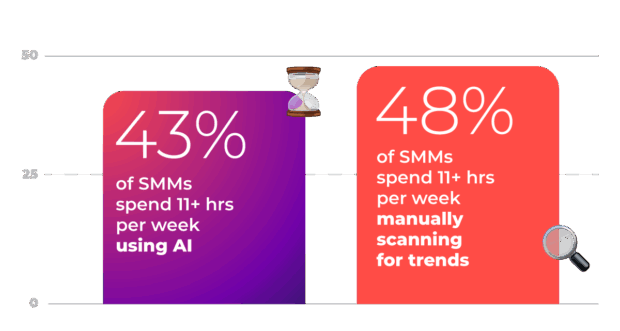
Most instruments don’t deal with development discovery both. Almost half (48%) of SMMs nonetheless spend over 11 hours every week manually scanning social platforms, and 1 / 4 (25%) spend greater than 16 hours. When AI can’t reliably floor what issues, groups are left to compensate, including guide labor to an already overloaded workflow.
All of this effort is perhaps worthwhile if the outputs have been reliable. However they’re not.
A 3rd of SMMs say they battle to determine which traits are value investing in, and one other 27% say they normally spot them too late. That leaves social groups spinning their wheels — sorting by noise, watching rivals transfer sooner, and questioning whether or not the hours spent with AI are serving to or hurting.
And the impression climbs the ladder. 59% of senior entrepreneurs say their campaigns are launching after the development window has closed. These delays aren’t about hesitation or bandwidth. They’re about visibility. Groups aren’t getting the suitable indicators quickly sufficient to behave.
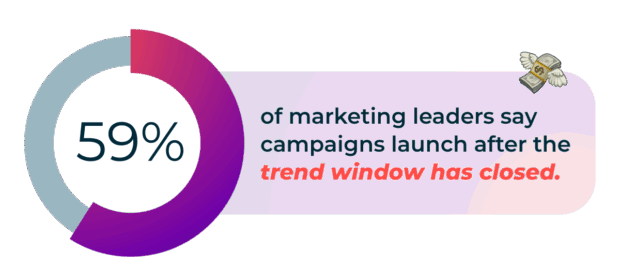
AI instruments promise scale, however after they’re not tuned to the tempo and nuance of social media, they only create extra layers to handle. Outputs want enhancing, context wants verifying, and what’s imagined to be automation turns into one other evaluate cycle.
This isn’t an effectivity acquire — it’s a redirection of effort. Groups are buying and selling one form of work for one more, typically with much less confidence and slower outcomes. And it’s not sustainable.
In case your group spends double-digit hours every week on AI however nonetheless misses the second, you don’t have a workflow; you’ve gotten a workaround.
Your AI doesn’t perceive social
Entrepreneurs know what nice social appears like. The issue isn’t their judgment — it’s the instruments they’re working with. Most AI wasn’t constructed for social. It pulls from outdated, basic net content material that doesn’t replicate how folks truly speak or what’s trending in actual time.
For a perform like social, the place context shifts hourly and cultural tone is the whole lot, that basis isn’t simply outdated. It’s unusable.
43% of social media managers say the content material they get from AI appears primarily based on basic net information fairly than social-specific sources. The language feels off, the insights are shallow, and it reads prefer it was written by somebody who’s by no means been on-line throughout a development cycle.
That disconnect between what groups want and what AI instruments present exhibits up on daily basis on the entrance traces.
When AI has a information hole like this, groups should compensate for that mismatch. 40% of social media managers say they often should double-check or edit AI-generated content material, not as a result of the concepts are completely mistaken however as a result of the tone, timing, or references are out of sync with what’s occurring proper now.
This disconnect erodes belief. Solely 28% of SMMs belief their present instruments to replicate what’s occurring on social media in actual time.
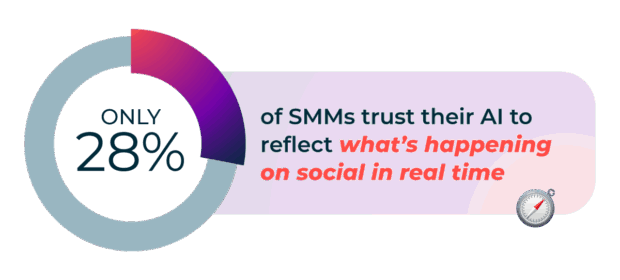
That’s staggeringly low, provided that these instruments are getting used each single day by groups that know they will’t absolutely depend on them.
You’re not working with dangerous AI. You’re working with blind spots.
In case your AI is drawing from stale sources, no quantity of immediate engineering or inner upskilling will shut the hole. You’re nonetheless ranging from an obstacle.
As Billy Jones, Head of Advertising at Hootsuite, places it:
Most generative AI instruments are already old-fashioned the second entrepreneurs use them. Conventional AI falls quick for entrepreneurs who function the place their prospects do: on social. If the insights aren’t grounded in what’s occurring on social proper now, they will’t drive actual impression.
Billy Jones
Head of Advertising, Hootsuite
That is the place frustration begins to appear to be failure, particularly for advertising and marketing groups beneath stress to maneuver quick, create at scale, and hit efficiency benchmarks. It’s not that they’re not working laborious sufficient; it’s that the tech is working in opposition to them.
The answer isn’t to tug again on AI. It’s to demand higher from it.
AI spend is rising, however so are expectations
83% of senior entrepreneurs say their AI budgets have elevated. Almost half now spend over 10% of their complete advertising and marketing price range on AI instruments, and one in 5 (20%) are spending greater than 20%. That form of funding indicators confidence — or not less than urgency.
However confidence doesn’t assure impression. And stress tends to comply with spend.
AI budgets are beneath the microscope now: not as a result of executives are anti-innovation, however as a result of they’re nonetheless ready to see the return. Groups have been promised automation, scale, and pace. What they’re getting as an alternative is a tangle of half-useful instruments that always fail on the one factor they’re imagined to do: make social simpler to execute and more practical to measure.
40% of senior entrepreneurs say they’ve wasted over 10% of their AI price range on instruments that didn’t ship, and greater than 1 / 4 say that quantity jumps previous 20%. That’s not simply disappointing. It’s career-risking in a local weather the place CFOs are scrutinizing each line merchandise.
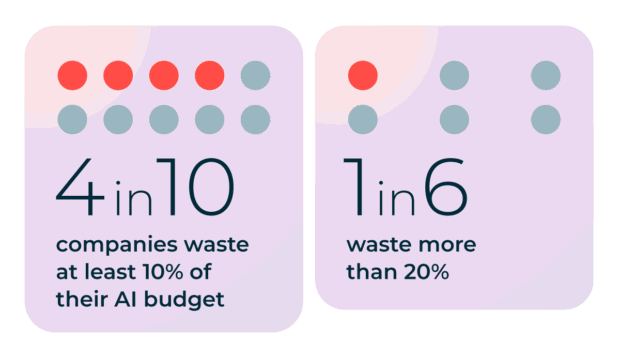
These expectations create a harmful dynamic for social groups. As a substitute of being freed as much as deal with artistic technique or group constructing, they’re caught justifying outputs, enhancing tone-deaf copy, or reverse-engineering efficiency from instruments that may’t clarify themselves.
Executives see the spend and anticipate outcomes. Social groups see the instruments and spot the cracks — gradual outputs, shallow insights, and missed moments.
The danger right here isn’t only a missed KPI. It’s the erosion of credibility. When groups can’t present clear wins from their AI investments, the notion shifts: not that the instruments failed, however that the group did.
That’s why merely rising AI spend gained’t resolve the issue. You may’t spend your approach out of a mismatch. In case your AI doesn’t perceive what makes content material resonate on social or can’t allow you to transfer quick sufficient to capitalize on a development, then each further greenback spent simply provides stress to show ROI with out supplying you with the instruments to attain it.
That is the inflection level. Advertising leaders have invested. Now they want instruments that may ship.
The issue isn’t AI itself. It’s the form of AI most social groups are utilizing.
Most advertising and marketing AI was by no means constructed for social. It pulls from static information sources, lacks real-time consciousness, and might’t parse the nuance of how folks converse on-line. It’s fluent in long-form weblog tone, not TikTok subtext. It doesn’t perceive when a put up is driving engagement versus backlash. And it leaves social groups doing the heavy lifting.
That doesn’t imply social and AI can’t work collectively. However for that relationship to work, the instruments must be constructed with social on the core, not as an afterthought.
A really social-first AI ought to be capable to floor real-time indicators, not simply recycle final month’s headlines. It ought to flag rising traits earlier than they crest and assist groups determine whether or not these traits are related, brand-aligned, and price chasing.
Social-first AI additionally wants to grasp tone and timing. It ought to know the distinction between a fleeting meme and a long-lasting shift in viewers conduct. It ought to acknowledge the cultural context that makes a marketing campaign land or flop.
It ought to cut back friction, not add to it. Social groups shouldn’t should rewrite each output, dig for lacking citations, or manually cross-check references simply to keep away from posting one thing tone-deaf.
Right here’s what that has to appear to be in observe:
Floor what’s occurring proper now, not final week’s headlines
Flag early-stage traits with context (not simply key phrases)
Perceive tone and timing, and the distinction between memes and actions
Ship content material that’s near publish-ready, not first-draft filler
Match into your workflows — no rebuilding, no exporting, no guesswork
Function / Functionality
Generic AI Instruments 🛑
Social-First AI (OwlyGPT) 🚀
Information sources
📰 Pulls from articles and boards
🌐 Incorporates real-time social platform information
Pattern detection
🐢 Sluggish and retrospective
🔍 Surfaces traits in actual time
Tone consciousness
🧱 Generic, blog-like tone
🎯 Designed to match platform tone and your model voice
Content material output
✏️ Wants rewriting and cleanup
✅ Near publish-ready
Contextual perception
🗂️ Fundamental outputs with little context or clarification
💡 Surfaces insights with viewers and cultural context
Workflow integration
🔌 Exterior, disconnected
🔄 Built-in into Hootsuite workflow
Response to fast-moving traits
⏰ Usually lags or misses the second
⚡ Surfaces early development indicators with brand-aligned context
Belief from social groups
🤷 Decrease confidence from social groups
🔐 Constructed for real-time accuracy groups can depend on
This isn’t a wishlist. It’s a requirement. As a result of the stress on social groups isn’t easing up, and the window to show AI’s worth is closing.
In case your present instruments can’t ship on that, it’s time to lift your expectations.
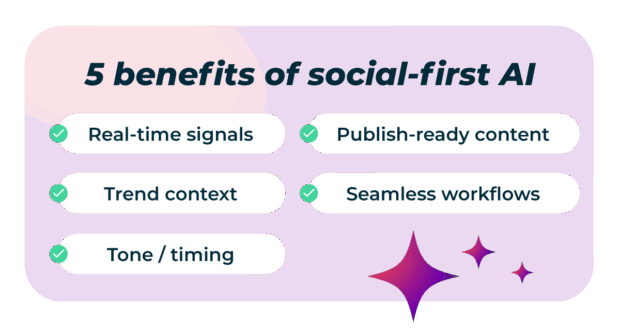
OwlyGPT: As a result of your different AI can’t sustain
Advertising’s AI second is right here — however most instruments weren’t constructed for the entrance traces. OwlyGPT is.

OwlyGPT is purpose-built for social media advertising and marketing, utilizing dwell social information to match the tempo, tone, and stress of right this moment’s on-line conversations.
The place different instruments guess at what’s trending, OwlyGPT exhibits you. It analyzes real-time conversations throughout platforms to floor what issues now, not final week or final quarter. And it doesn’t simply hand you an inventory of hashtags or key phrases. It provides you context, relevance, and route, so you possibly can determine what’s value chasing and what’s not.
As a result of it’s constructed on dwell social indicators, OwlyGPT displays the tone, tempo, and nuance of how folks truly converse on-line. No extra robotic copy that sounds prefer it was pulled from a B2B weblog or rewriting AI content material to match your viewers. No extra wasted hours enhancing half-right drafts into one thing usable.
Plus, OwlyGPT integrates immediately into your present workflows. You may immediate it for put up copy, development summaries, or marketing campaign concepts with out leaving Hootsuite.
OwlyGPT pulls platform-native insights in actual time — like how your viewers engages on Instagram — that will help you transfer quick and keep related.
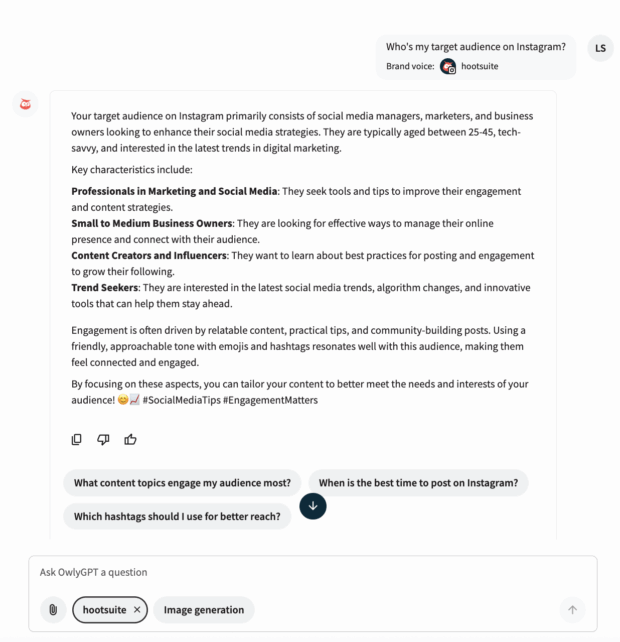
You may construct content material and acquire insights immediately from what’s occurring in your area, with confidence that the info is present and the tone is true.
Social is likely one of the richest sources of real-time information obtainable. And but, conventional AI instruments nonetheless can’t harness it. OwlyGPT turns insights from real-time social information into actual enterprise impression
Irina Novoselsky
CEO at Hootsuite
OwlyGPT isn’t attempting to exchange your group’s creativity or strategic judgment. It’s right here to take away the friction between perception and execution. To make it simpler to identify alternatives, reply in the suitable voice, and get content material out whereas it nonetheless issues.
That’s what social-first AI is meant to do. And that’s what OwlyGPT delivers.
Nonetheless utilizing AI that’s caught prior to now? OwlyGPT is the one social AI assistant skilled on right this moment — not the archives. It scours dwell social feeds to generate highly effective insights and content material primarily based on what your viewers is speaking about on-line proper now. Attempt it free right this moment.
Why do many AI instruments fail social media groups?
Many AI instruments are skilled on outdated or generic net information, not real-time social conversations. In consequence, they will miss traits, tone, and timing — three issues social groups can’t compromise on.
What’s the largest hole between leaders and social media managers relating to AI?
64% of senior entrepreneurs imagine their AI instruments use real-time information, however solely 39% of social managers agree — a significant misalignment that exhibits how totally different the front-line expertise is.
Does AI truly save social media managers time?
Not at all times. In actual fact, 43% of social media managers spend greater than 11 hours every week working with AI instruments, and plenty of nonetheless monitor traits manually. As a substitute of lowering workload, AI typically provides to it.
Why is belief in AI so low amongst social groups?
Solely 28% of social media managers belief that AI displays what’s occurring on social in actual time. Content material typically wants heavy enhancing as a result of tone and context are off.
What are the advantages of social-first AI?
A social-first AI can floor real-time indicators, flag early traits with context, perceive tone and timing, and ship content material that’s near publish-ready, with out including additional guide work.
How is OwlyGPT totally different from different AI instruments?
OwlyGPT is purpose-built for social media. It makes use of dwell social information, displays a platform-native tone, surfaces traits early, and integrates immediately into Hootsuite workflows so groups can transfer sooner and with extra confidence.





